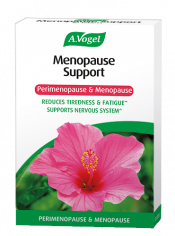Today's topic
Today on A.Vogel Talks Menopause, I take a look at three ways too much salt can impact your menopause symptoms.
We know that sugar can have a huge impact on our menopause symptoms, but what most people don't realise, is that the same can be said for salt. So, I thought I would look at three areas where too much salt can impact on your menopause symptoms. Plus, what you can do to reduce your salt intake during menopause.
1. High Blood Pressure
If we have too much salt in our diet, this can cause water retention and that can raise your blood pressure. In turn, that can put pressure on your heart and other organs, such as your kidneys and your brain.
Research also shows that menopause women can become sensitive to salt or more sensitive to salt.1 So salt can have a bigger impact on your health as you go through the menopause compared to what would have happened beforehand.
High blood pressure is one of those less commonly understood menopause symptoms. We do know that it can happen to a lot of women. But, unfortunately, there are very few symptoms. So, a lot of women are ending up experiencing high blood pressure without realising it.
And, of course, if you then add in lots of extra salt, this can compound the problem, which is not a good idea at all.
2. Dehydration
Too much salt can cause dehydration. And I'm sure we've all done it. We've had a packet of salted nuts or a takeaway and suddenly, you feel so thirsty. And it's because salt will dehydrate you.
Dehydration by itself can trigger a whole range of menopause symptoms, such as hot flushes, and night sweats, anxiety, palpitations, headaches, and joint pain.
3. Bloating
Another symptom that can be affected is bloating due to water retention. If we're having too much salt this can cause water retention, which can cause swelling in several areas of the body. A lot of women tell me that they find that their fingers start to swell and their rings hurt or they can't get their rings on. Another very common area for water retention is the ankles.
Research has shown that too much salt can cause intestinal bloating.2 So, it's not just certain foods that can give us that tummy bloat, but it can also be the salt content as well. And too much salt, too, can cause digestive cramps. So, if you get these symptoms, then just have a look at your diet to see if you're eating too much salt here.
How much salt is too much?
We do need a certain amount of salt for our body to function properly, especially to help with proper fluid balance. Salt is also needed for proper nerve function and proper muscle function. But we only need a small amount daily.
The recommended amount here in the UK is 6 grams of salt, which is roughly a teaspoonful. So, it's not a lot.
Salt cravings
If you get salt cravings and find that you are severely craving salt a lot, it is important to speak with your doctor because this could indicate health issues, such as adrenal fatigue.
Tips to help you reduce your salt intake

So how can you just keep an eye on your salt? There are a lot of simple things that you can do.
Watch how much salt you're putting in your cooking
Unless I'm making soup or things like casseroles, I don't put any salt in anything that I'm cooking. What I do is once it's cooked, I taste it, and if I think it needs a little bit of salt, I'll just sprinkle a little bit on.
One of the things that I realised is if you have a salt shaker, very often, you end up putting more salt than you need. So, I always put a little bit of salt in the palm of my hand and then just sprinkle it on my food, and you have much more control of how much you're putting on, rather than just shaking it all over.
Use other seasonings to flavour your food
You can use other seasonings, such as herbs, such as spices, and pepper as well is another nice one to use, which can work well to bring out the flavour of your food.
Replace your table salt with healthier alternatives
Table salt, the white table salt that most people use is refined. Everything's been taken out of it to make it look pretty. Whereas natural salts, such as your sea salts, your Himalayan salts, your natural salts, they can come in all different colours, and the reason for that is they contain a whole range of minerals in very tiny amounts, which can be beneficial for our health.
We do a lovely range of salt called Herbamare, which contains a combination of sea salt and a mixture of herbs and spices. We have our original salt, a low salt one, and we also do a spicy salt, too.
I love this range, I find it's great on things like baked potatoes and in egg dishes.
My Top Tip:

"I have been using this for years now I love it and always use it instead of salt, it is healthier and enhances food much more than salt." Julie Jordan

Check your food labels
You should always check food labels when you're doing your shopping. A lot of the supermarkets now, having coding on their packets. So, the greens low, amber is medium, and red is high in salt and sugar. So just double-check, if you're buying from the supermarket, how much salt is in your food.
According to the NHS, around 75% of the salt we eat is already in everyday foods.3 So, look at your cheeses, things like crisps, salted nuts, your pizzas, ready meals, and processed meats, such as the bacon and cold meat.
But there are also some surprising foods as well. A couple of slices of bread or a bowlful of breakfast cereal will contain almost 1 gram of salt. So, by having two pieces of bread and a bowl of cereal for your breakfast, you are consuming a third of your daily salt intake. So, it can be really interesting and quite shocking just to look at all the food labels and the salt that's in your foods.
I hope this has helped. Too much salt in our diet can be a big issue, but we do tend not to be so fussy and careful about it than we do about sugar, but it's still very important. If any of you have any tips on how you reduced your salt, we would love to hear about it.
Until next time, take care.
References
1. https://www.ahajournals.org/doi/pdf/10.1161/01.HYP.0000218857.67880.75
3. https://www.nhs.uk/live-well/eat-well/tips-for-a-lower-salt-diet/





 Looking for a healthier alternative to regular salt? Well, look no further!
Looking for a healthier alternative to regular salt? Well, look no further!


